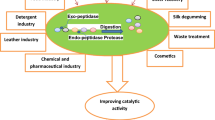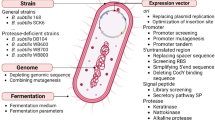Abstract
This paper describes the results of a comparative screening between the nematophagous Antarctic fungus Arthrobotrys tortor and other species of that genus for the production of extracellular collagenases. The nematode species used in this study was Caenorhabditis elegans, feeding on Escherichia coli cultures. Determination of collagenase activity was made using insoluble collagen from bovine Achilles tendon and determining the amount of solubilized hydroxyproline produced. The results show that the total amount of collagenase produced by the Antarctic strain of A. tortor was about threefold higher than that observed for the other species. In the Antarctic strain, collagenase was shown to be a constitutive enzyme.
Similar content being viewed by others
References
Dackman C, Nordbring-Hertz B. Conidial traps - a new survival structure of the nematode-trapping fungus Arthrobotrys oligospora. Mycol Res 1992; 96: 194–198.
Dackman C, Jansson H-B, Nordbring-Hertz B. Nematophagous fungi and their activities in soil. In: Stotzky G, Bollag JM, eds. Soil Biochemistry 1992; 7: 95–130.
Nordbring-Hertz B. Nematophagous fungi: strategies for nematode exploitation and survival. Microbiol Sci 1988; 5: 108–116.
Tunlid A, Janson S. Proteases and their involvment in the infection and immobilization of nematodes by the nematophagous fungus Arthrobotrys oligospora. Appl Environ Microbiol 1991; 57: 2868–2872.
Tunlid A, Rosen S, Nordbring-Hertz B. Molecular mechanisms of adhesion in the nematophagous fungus Arthrobotrys oligospora. J Mycol Méd 1992; 2: 36–42.
Tunlid A, Jansson H-B, Nordbring-Hertz B. Fungal attachment to nematodes. Mycol Res 1992; 96(6): 401–412.
Veenhuis M, Harder W, Nordbring-Hertz B. Occurence and metabolic significance of microbodies in trophic hyphae of the nematophagous fungus Arthrobotrys oligospora. Antonie van Leeuwenhoek 1989; 56: 241–249.
Veenhuis M, van Wijk C, Wyss U, Nordbring-Hertz B. Significance of electron dense microbodies in trap cells of the nematophagous fungus Arthrobotrys oligospora. Antonie van Leeuwenhoek 1989; 56: 251–261.
Olthof ThHA, Estey RH. A nematotoxin produced by the nematophagous fungus Arthrobotrys oligospora Fresenius. Nature 1963; 197: 514–515.
Balan J, Križkova L, Nemec P, Voller V. Production of nematode-attracting and nematicidal substances by predaceous fungi. Folia Microbiol 1974; 19: 512–519.
Barron GL, Thorn RG. Destruction of nematodes by species of Pleurotus. Can J Bot 1987; 65: 774–778.
Stadler M, Anke H, Sterner O. Linoleic acid - The nematicidal principle of several nematophagous fungi and its production in trap-forming submerged cultures. Arch Microbiol 1993; 169: 401–405.
Anke H, Stadler M, Mayer A, Sterner O. Secondary metabolites with nematicidal and antimicrobial activity from nematophagous fungi and Ascomycetes. Can J Bot 1995; 73(suppl 1): S932–S939.
Tunlid A, Rosèn S, Ek B et al. Purification and characterization of an extracellular serine protease from the nematode-trapping fungus Arthrobotrys oligospora. Microbiology 1994; 140: 1687–1695.
Schenck S, Chase T Jr, Rosenzweig WD, Pramer D. Collagenase production by nematode-trapping fungi. Appl Environ Microbiol 1980; 40(3): 567–570.
Caretta G, del Frate G, Tosi S. Nematophagous activity on moss as cultural substratum of Arthrobotrys tortor Jarowaja isolated in Antarctica. Boletíno Micològico 1995; 10(1-2): 37–41.
Jarowaja N. Arthrobotrys tortor sp. nov. New predaceous nematode-killing fungus. Acta Mycol 1968; 4: 241–247.
Schenck S, Kendrick WB, Pramer D. A new nematode-trapping hyphomycete and a reevaluation of Dactylaria and Arthrobotrys. Can J Bot 1977; 55: 977–985.
Oorschot CAN van. Taxonomy of the Dactylaria complex.V. A review of Arthrobotrys and allied genera. Stud Mycol 1985; 26: 61–95.
Caretta G, Del Frate G. Mangiarotti AM. A record of Arthrobotrys tortor Jarowaja and Engyodontium album (Limber) de Hoog from Antarctica. Boletín Micològico 1994; 9: 9–13.
Caretta G, Piontelli E. Microsporum magellanicum and Cunninghamella antarctica, new species isolated from Australian and antarctic soil of Chile. Sabouraudia 1977; 15: 1–10.
Caretta G, Mangiarotti AM, Piontelli E. Coprophilous fungi on horse, goat and sheep dung from Lombardia (Italy). Mic Ital 1994; 2: 11–20.
Lowry OH, Rosebrough NJ, Farr AL, Randall R J. Protein measurement with the Folin phenol reagent. J Biol Chem 1951; 193: 265.
Huszar G, Maiocco J, Naftolin F. Monitoring of collagen and collagen fragments in chromatography of protein mixtures. Annal Biochem 1980; 105: 424.
Laemmli UK. Cleavage of structural proteins during the assembly of the head of bacteriophage T4. Nature 1970; 227: 680.
Viglio S, Zanaboni G, Luisetti M, Cetta G, Guglielminetti M, Iadarola P. Micellar electrokinetic chromatography: a convenient alternative to colorimetric and high performance liquid chromatographic detection to monitor protease activity. Electrophoresis 1998; 19: 2083.
Hurion N, Fromentin H, Keil B. Specificity of the collagenolytic enzyme from the fungus Entomophthora coronata: comparison with the bacterial collagenase from Achromobacteriophagus. Arch Biochem Biophys 1979; 192: 438–445.
Scifter S, Harper E. Collagenases. Methods Enzymol 1970; 19: 613–635.
Duddington CL. The ecology of predaceous fungi. Trans Brit Myc Soc 1951; 34: 322–331.
Gray NF, Smith RIL. The distribution of nematophagous fungi in the maritime Antarctic. Mycopathologia 1984; 85: 81–92.
Gray NF. Nematophagous fungi from the maritime antarctic: factor affecting distribution. Mycopathologia 1985; 90: 165–176.
Jansson HB, Tunlid A, Nordbring-Hertz B. Nematodes. In: Anke T, ed. Fungal Biotechnology. Chapman and Hall, Boca Raton, Florida, U.S., 1997: 38–50.
Author information
Authors and Affiliations
Rights and permissions
About this article
Cite this article
Tosi, S., Annovazzi, L., Tosi, I. et al. Collagenase production in an Antarctic strain of Arthrobotrys tortor Jarowaja. Mycopathologia 153, 157–162 (2002). https://doi.org/10.1023/A:1014511105803
Issue Date:
DOI: https://doi.org/10.1023/A:1014511105803




